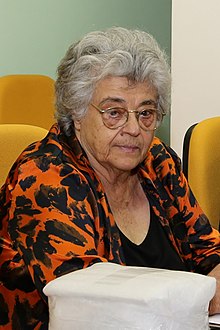Niède Guidon
Niède Guidon (born March 12, 1933 , in Jaú , Brazil ) is a Brazilian archaeologist . It is at the center of a scientific controversy about when America was settled .
resume
Guidon began her academic career studying biology and science at the University of São Paulo . She later studied prehistory and early history in France . While working in a museum in São Paulo in 1963 , she was presented with photographs of rock paintings from São Raimundo Nonato in the Piauí province . They depicted hunting, sex and violence scenes, the style of the paintings differed significantly from other rock paintings known to Guidon. After they settled during the time of the military dictatorshiphad stayed in exile in France, she returned to Brazil. She visited São Raimundo Nonato in the 1970s and began to research the rock art in what is now the Brazilian Serra da Capivara National Park . The Serra da Capivara is now considered to be the largest finding site of prehistoric settlements and rock paintings in South America. Guidon is the senior archaeologist there, but announced in 2018 at the age of 85 that he would be moving to France. To date, more than 400 settlement sites and over 30,000 rock drawings have been discovered in the Serra.
To date the rock paintings, she used, among other things, the determination of the age of nearby fireplace remains.
Boqueirão da Pedra Furada
By determining the age of the remains of coal from a fireplace on the rock face Boqueirão da Pedra Furada in the Serra da Capivara National Park , she came to the conclusion that this area must have been inhabited around 30,000 years ago. This contradicted the Clovis theory, named after the Clovis culture , according to which the colonization of America via the Bering Strait was only about 12,000 years ago by people of the Mongolian " great race ". Experts of the Clovis theory object that the fire investigated by Guidon could also have been of natural origin. However, the Clovis theory is now being called into question by more recent finds, such as finds in Monte Verde, Chile, and a footprint in fossilized volcanic ash that is said to be between 25,000 and 30,000 years old in the Mexican state of Oaxaca near Santo Tomás Jalieza.
Awards
In 2005 Niède Guidon was honored with the Prince Claus Prize .
Individual evidence
- ↑ Lilo Berg: In the footsteps of the first Americans. June 7, 2018, accessed June 30, 2018 .
- ↑ Niède Guidon, Georgette Delibrias: Carbon-14 dates point to be in the Americas 32,000 years ago. In: Nature . Vol. 321, No. 6072, 1986, pp. 769-771, doi : 10.1038 / 321769a0 .
- ^ John Noble Wilford: Findings Plunge Archeology of the Americas Into Turmoil Estimates of first Asian migration are 33,000 years apart. ( Memento of the original from May 26, 2008 in the Internet Archive ) Info: The archive link was inserted automatically and has not yet been checked. Please check the original and archive link according to the instructions and then remove this notice. In: New York Times , dated May 30, 1989 (English, on the debate among archaeologists).
- ^ Paul Bahn: Dating the first American: When did people first enter the New World? Clues from distinctive rock art may push the date back by thousands of years. In: New Scientist. Issue 1778, July 20, 1991, p. 26.
Web links
- Interview with Guidon (English)
- Luis Carlos Duarte Cavalcante: Uma mulher chamada Niéde , in: Jornal da Ciência, March 14, 2005 (brasil.)
- Prêmio Claudia: Niède Guidon : Article in the Claudia magazine on the award of the Prêmio Claudia 1997 (brasil.)
- The treasure of the Serra da Capivara
- American Settlement History. Sensational finds: The New World is much older , ZDF , February 19, 2017
| personal data | |
|---|---|
| SURNAME | Guidon, Niède |
| BRIEF DESCRIPTION | Brazilian archaeologist |
| DATE OF BIRTH | March 12, 1933 |
| PLACE OF BIRTH | Jaú (São Paulo) , Brazil |





